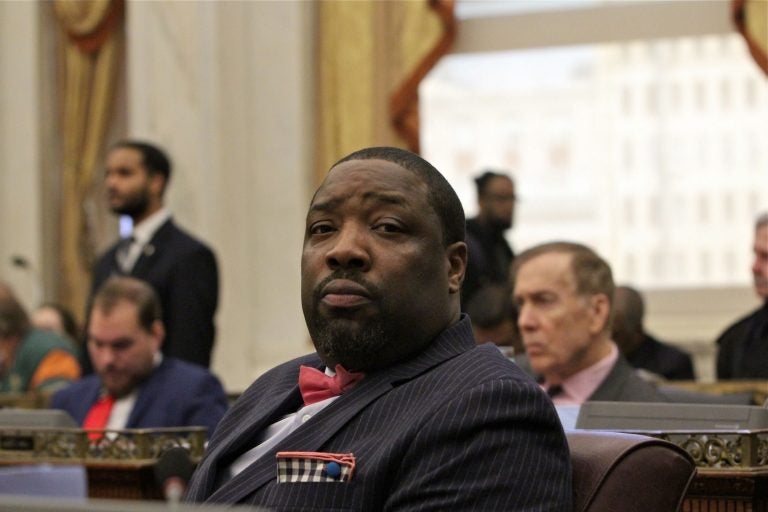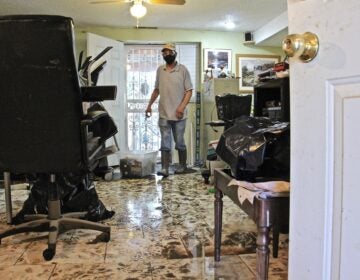Kenyatta Johnson’s new Eastwick task force to tackle buyout question
The new task force will include FEMA, the U.S. Army Corps of Engineers, and the U.S. Environmental Protection Agency as well as city and state agencies.

Philadelphia City Council member Kenyatta Johnson (Emma Lee/WHYY)
Southwest Philadelphia’s Eastwick now has a special task force to address immediate and long-term flooding issues in the neighborhood. The new intergovernmental body will bring together city, state and federal officials to work on a solution to the problem, which has plagued the predominantly Black neighborhood since city government displaced thousands of people to develop it over a marshland and next to a landfill.
“Ultimately, we just want to make sure that we keep the same priorities on a city level, on a state level, as well as on a federal level, and continue to aggressively work, with a sense of urgency, to address the issue of flood mitigation in Eastwick,” said Councilmember Kenyatta Johnson who has represented the neighborhood for eight years.
Johnson said that he created the task force after hosting a virtual Town Hall last Monday with more than 170 participants, including representatives of local, state, and federal agencies working in the neighborhood.
The meeting helped him realize that residents still have a lot of questions on the work public agencies are doing — and how that work connects back to solving the problems they face as they navigate repair bills, flood insurance premiums and other recovery pain points. Eastwick was developed as part of a midcentury urban renewal project intended to provide desirable homes at affordable prices and help people generate wealth, but the plan backfired when it became clear the homes were built on vulnerable land in a contaminated area that is now a Superfund site.
About 130 Eastwick residents have flooded more than 10 times in the last 20 years, due to increased development of land located upstream of the Darby and Cobbs creeks and stronger storms.
“For me, the task force will also provide a level of accountability to make sure that we have a concrete plan, but also action — beyond these studies — that is actually taking place,” Johnson said.
The task force will meet bimonthly and include representatives from federal agencies such as FEMA, the U.S. Army Corps of Engineers, and the U.S. Environmental Protection Agency; city agencies such as the Managing Director’s Office, the Office of Emergency Management, and the Philadelphia Housing Development Corporation, which is now in the beginning stages of implementing the Lower Eastwick Public Land Strategy to reuse almost 200 acres of public land from the botched urban renewal project.
The task force will also include federal and state elected officials such as House Representative Mary Gay Scanlon, State Senator Anthony Williams and Representative Maria Donattucci; as well as community leaders.
Terry Williams, a longtime Eastwick resident and activist, and chair of the city’s Lower Eastwick Public Land Strategy, said the task force is needed.
“As much as Eastwick has flooded, there needs to be a conversation about what the next steps are for the over 100 people who had been severely affected by this flood,” Williams said.
“Hopefully, it will come up with some recommendations that will alleviate the trauma, the expense, and bring some normalcy to those folk in Eastwick who have flooded.”
Some neighbors want buyouts
Vanessa Johnson is tired of waiting for a solution for flooding in her neighborhood.
She and her husband bought her house on Apollo Place in 1977 in what’s now referred to as “the planet streets” section of Eastwick. It’s one block from the Darby Creek and the former landfill that is now a Superfund site, and it usually gets flooded.
When Johnson and her husband bought their then-new home, they didn’t know the city had built it over marshland and next to a landfill. FEMA flood maps were first adopted in Philadelphia in 1978. And the first time she flooded was with Hurricane Floyd, in 1999. She said her salary as a case worker for the state was not enough to afford about $3,000 in flood insurance, so she still doesn’t have it.
With Isaias, she says she got four feet of water, lost her car, her washing machine and dryer and her heater. At 67 years old, she said she can’t keep cleaning walls, replacing walls and buying new appliances — she wants out.
“It’s been 20 years and nothing really has been done,” Johnson said at the virtual Town Hall meeting hosted by Councilmember Johnson on Monday. “We waited 20 years for this to happen again. So you know, what’s going to happen between the next 20 years? I might not be here, but it seems like nothing is being resolved in reference to the water.”
Buyouts are a potential solution for some property owners affected by flooding, Joshua Lippert, the city’s Floodplain Manager, told Johnson and other residents asking about the possibility of selling their flooded homes back to the government.
“It is a tool that’s in our toolkit that the city could explore. And there are federal programs that can assist the city in funding buyout programs, with the caveat that they’re extremely challenging,” Lippert said.
After Hurricane Floyd, in 1999, there were multiple buyouts in Darby, but only four properties got bought using federal funds in Eastwick. That’s been attributed to two challenges, Lippert said. First, the federal government is very strict in terms on how much they will pay for properties and second, because many of the houses in Eastwick are rowhomes.
“FEMA likes the entire row to be buyout, not just the individual teeth along the row, so there are some challenges in terms of getting everyone within a row to participate in a buyout,” Lippert said.
The homes bought in 1999 were a set of two twins.
Joel Dohm of the U.S. Army Corps of Engineers, or USACE, said the buyout scenario is also difficult because of economics. For the federal government to fund buyouts, it has to have been selected as the best alternative after a cost-benefit analysis that evaluates which way of allocating resources is most effective.
“And that real estate component is very expensive,” Dohm said.
Dohm is currently leading such a study in Eastwick, in collaboration with Philadelphia Water Department, to reduce risk damage and risk in the neighborhood. The study started last year in May, and has two more years to go.
Dohm said the study will consider different structural solutions — such as levees, flood walls, diversion channels, pumping or bridge modifications — as well as non-structural solutions, such as buyouts and relocations, advanced warning systems, and improved evacuation routes.
A previous USACE study has already determined that a levee would not be enough to solve the issue.
“Hopefully, at the very end of these three years, we shake hands with Philadelphia Water Department on an agreed-upon plan, where we then implement some sort of design, structural or non-structural, and then it becomes Philadelphia Water Department’s responsibility after construction,” Dohm told residents.
Eventual construction or implementation of the study depends on federal funding and other requirements, according to USACE.
Longtime Eastwick leader Terry Williams said he doesn’t think buyouts are viable because people are not willing to leave. He said many residents have lived there for a long time, love the neighborhood and are too old to think of starting over again somewhere else.
“I can’t think of one of them that said they wanted to be bought out,” he said. “I don’t know if the motivation, even after this recent flooding, would bring that result to a majority.”
Johnson, disagrees.
“Most of my neighbors are ready to go,” she said.
She loves the neighborhood, she said, but with no solution in sight and climate projections saying the city will get more precipitation and stronger storms in the near future, she doesn’t see another way out.
“I’m older now… I can’t deal with it anymore,” she said.
For now, Williams thinks the neighborhood needs a governmental office located in the neighborhood, where residents could go if they need recovery resources.
“There are a plethora of agencies that have responsibility for these flood situations,” Williams said. “People have to navigate all of these agencies in order to try to be made whole in this disaster situation. I think that it is very logical and it would be very beneficial to have a clearing house-type situation here in Eastwick.”
He said city officials have promised such a community-based resource in the past but the office never materialized.
“I think that that idea of a mini-City Hall is even more important now, given the fact that a significant number of folks have been affected as a result of this latest flood,” Williams said.
Councilmember Johnson said his office hasn’t yet determined the feasibility of a neighborhood office. He said other neighbors want to know if buyouts are possible or the dredging can be done to make the area less vulnerable to flooding. The task force will help them move forward and answer questions about what is possible, he said.
“With all the key stakeholders at the table, we can explore the options,” Johnson said.
The first meeting of the task force will be in September.

Get daily updates from WHYY News!
WHYY is your source for fact-based, in-depth journalism and information. As a nonprofit organization, we rely on financial support from readers like you. Please give today.








